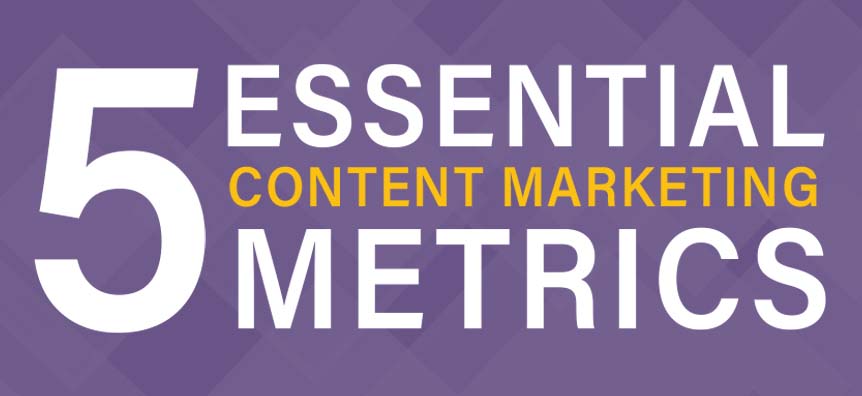Developing and publishing content on a consistent basis has many benefits to online marketing. It can help improve your overall SEO strategy, increase social sharing and brand awareness, drive traffic to your web site and even create opportunities to earn those coveted inbound links.
As often as you publish new content and the quality of such content, how is one to know if their content marketing strategy is effective or not? What metrics should content marketers be looking at so that their campaigns can be successful?
The following infographic takes a look at 5 essential content marketing metrics. These include metrics related to leads, consumption, retention, sharing and finally, what most of us care about, sales.
Here is the original infographic for those of you who prefer to “visualize” information, followed by a textual version (with corrected grammar and spelling) for those of you who just want the data. Enjoy and start measuring effectively so you can get the best ROI on your content marketing efforts.
[Click image for full size version]
5 Essential Content Marketing Metrics
Content marketing is an important part of any business. Measure the effectiveness of your content marketing efforts with these metrics.
- 89% of marketers ranked “improving the ability to measure and analyze marketing impact” as a top priority.
- 70% of Internet users want to learn about products through content versus traditional advertisements.
- 75% of people who find local, helpful information in search results are more likely to visit the physical stores.
- 63% of marketers say their top challenge is generating traffic and leads.
1. Lead Metrics
New Leads Generated
Use marketing automation and CRM tools such as MailChimp, Reach Mail, Drip, and Constant Contact, to calculate new leads.
Existing Leads Touched
To calculate the existing leads in your database that have interacted with a piece of content, use marketing automation and CRM tools.
Funnel Conversion Rate
Measure the rate of which leads move through the marketing funnel. (Funnel conversion rate = Number of leads that have moved to the next stage in the funnel/leads in funnel stage) x 100.
“Content is the fuel for your lead generation efforts.”
2. Consumption Metrics
Page Views
Page views provide you insight into what your visitors are consuming. This can help you find content that is performing well while eliminating poor content.
Average Time on Page
Average time on a page gives you insight as to whether users are quickly skimming through your content or sticking around.
Email Opens
A good range of “open” rate is between 15% and 25% for marketing emails and between 30% to 40% for transactional emails. Email marketing tools like MailChimp, Marketo and others will tell you how many people opened your email and at what time. This gives you an insight into the best days and times to publish your content.
3. Retention Metrics
Return Rate
Return rate shows you how many of your users are return visitors versus new ones.
Unsubscribes and Opt-Outs
Track the retention of existing email list subscribers by keeping an eye on unsubscribes and opt-outs.
Bounce Rate
Bounce rate is essentially calculated by how much time a person spends on your site. Bounce rate = The number of visitors who leave a web site after only visiting the landing page / the total number of visitors to the page. You can calculate bounce rate within Google Analytics.
4. Sharing Metrics
Social Media Shares
Use social media tools such as Buzzsumo and Hootsuite to identify the types of content that motivate visitors to share.
Social Media Likes
Similar to social media shares, you can measure likes/loves.
Comments
Many conversations happen on social media rather than the blog comments box. The number of comments on a given piece of content may reveal how well the piece is performing.
Global Facebook Reach & Engagement
- Average monthly change in page likes – +0.20%
- Average post reach vs. page likes – 10.7%
- Average organic reach vs, page like – 8%
- Percentage of pages using paid media – 22.1%
- Average paid reach vs. total reach – 26.8%
- Average engagement (all post types) – 4.2%
- Average video post engagement – 5023%
- Average photo post engagement – 4.42%
- Average link post engagement – 3.9%
- Average status post engagement – 3.7%
5. Sales Metrics
Pipeline Generated
Using a first-touch attribution model, you can aggregate the total dollar value of all opportunities where the first touch of the lead associated with the opportunity was in a piece of your content.
Pipeline Touched
You can aggregate the total value of all opportunities, where the lead associated with the opportunity has touched a particular piece of content.
Revenue Influenced
Look at the dollar value of revenue closed where the contact associated with the deal consumed one or more pieces of your content prior to converting.
In Conclusion…
Measure, measure, and measure again to find out what works and what does not. Continue to produce the content that is working for you and don’t waste time and effort on content that does not. And if you need help with your content marketing strategy, check out our Content Marketing services page to see what we can offer you.










